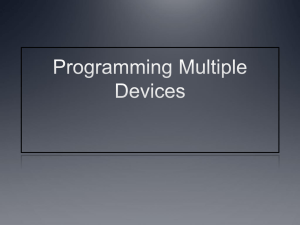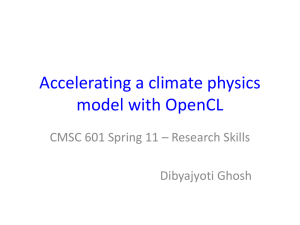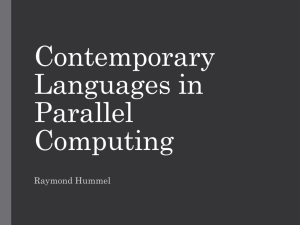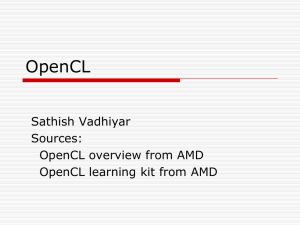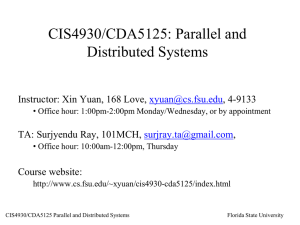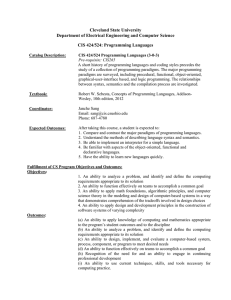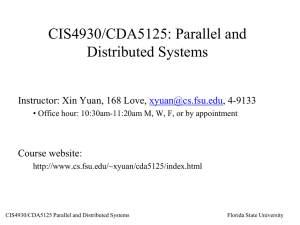Akhtar Ali, Usman Dastgeer and Christoph Kessler. OpenCL on shared... multicore CPUs. Proc. MULTIPROG-2012 Workshop at HiPEAC-2012, Paris, Jan.
advertisement
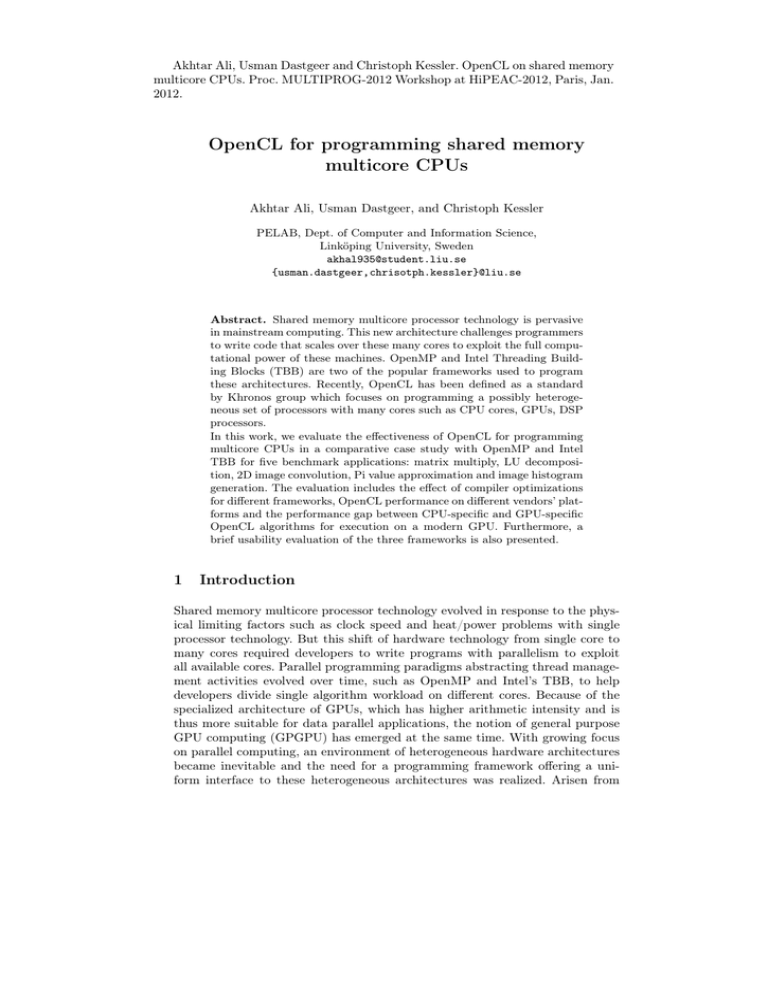
Akhtar Ali, Usman Dastgeer and Christoph Kessler. OpenCL on shared memory
multicore CPUs. Proc. MULTIPROG-2012 Workshop at HiPEAC-2012, Paris, Jan.
2012.
OpenCL for programming shared memory
multicore CPUs
Akhtar Ali, Usman Dastgeer, and Christoph Kessler
PELAB, Dept. of Computer and Information Science,
Linköping University, Sweden
akhal935@student.liu.se
{usman.dastgeer,chrisotph.kessler}@liu.se
Abstract. Shared memory multicore processor technology is pervasive
in mainstream computing. This new architecture challenges programmers
to write code that scales over these many cores to exploit the full computational power of these machines. OpenMP and Intel Threading Building Blocks (TBB) are two of the popular frameworks used to program
these architectures. Recently, OpenCL has been defined as a standard
by Khronos group which focuses on programming a possibly heterogeneous set of processors with many cores such as CPU cores, GPUs, DSP
processors.
In this work, we evaluate the effectiveness of OpenCL for programming
multicore CPUs in a comparative case study with OpenMP and Intel
TBB for five benchmark applications: matrix multiply, LU decomposition, 2D image convolution, Pi value approximation and image histogram
generation. The evaluation includes the effect of compiler optimizations
for different frameworks, OpenCL performance on different vendors’ platforms and the performance gap between CPU-specific and GPU-specific
OpenCL algorithms for execution on a modern GPU. Furthermore, a
brief usability evaluation of the three frameworks is also presented.
1
Introduction
Shared memory multicore processor technology evolved in response to the physical limiting factors such as clock speed and heat/power problems with single
processor technology. But this shift of hardware technology from single core to
many cores required developers to write programs with parallelism to exploit
all available cores. Parallel programming paradigms abstracting thread management activities evolved over time, such as OpenMP and Intel’s TBB, to help
developers divide single algorithm workload on different cores. Because of the
specialized architecture of GPUs, which has higher arithmetic intensity and is
thus more suitable for data parallel applications, the notion of general purpose
GPU computing (GPGPU) has emerged at the same time. With growing focus
on parallel computing, an environment of heterogeneous hardware architectures
became inevitable and the need for a programming framework offering a uniform interface to these heterogeneous architectures was realized. Arisen from
2
OpenCL for programming shared memory multicore CPUs
this need is the Open Computing Language (OpenCL) standard API that is
based on ISO C99 standard. OpenCL abstracts the underlying hardware and
enables developers to write code that is portable across different shared-memory
architectures.
Individually, these frameworks have been studied extensively such as OpenMP
in [2, 12], TBB in [6, 13] and OpenCL in [7, 8]. There is still lot of work focused
only on CPU specific [9, 10] and GPU specific [1, 4, 5] frameworks comparisons.
But there is comparatively little work evaluating OpenCL CPU performance
with that of state-of-the-art CPU specific frameworks. Evaluating OpenCL on
CPUs is becoming increasingly important as OpenCL implementations are available for CPUs by AMD and Intel. Due to its promise for code portability,
OpenCL could provide the programming foundation for modern heterogeneous
systems. An important study in this direction is [3] examining overhead, scalability and usability of five shared memory parallelism frameworks including
OpenCL on a 2D/3D image registration application. In our work, we choose
OpenMP and TBB as popular representatives of CPU specialized frameworks
and compare these with OpenCL, on five benchmark applications to provide a
wider base for comparison. We do the evaluation in the following aspects:
– OpenCL as an alternative to Intel TBB and OpenMP for programming multicore CPUs: How does it compare in terms of performance, compiler support, programming effort and code size.
– OpenCL specific issues: such as performance implications of different vendor’s OpenCL’ implementations, CPU-specific vs GPU-specific optimizations for an OpenCL algorithm and performance implications of these optimizations.
2
2.1
Frameworks
OpenMP
Open Multi Processing (OpenMP) provides parallelizing facilities in C/C++
and Fortran by using preprocessor directives/pragmas, library routines and environment variables and is supported by most compilers today. These directives
enable generation of multi-threaded code at compile time [10]. Although there
exists a commercial implementation of OpenMP on clusters [2], its prime target
are shared memory architectures. It provides a very easy to use high level application programming interface for multi-threading computationally intensive
data and task parallel programs. Most OpenMP implementations use thread
pools on top of the fork/join model, which exist throughout execution of the
program and therefore avoid the overhead of thread creation and destruction
after each parallel region [11]. Its work sharing constructs such as omp for in
C/C++ (and omp do in Fortran) provide data parallelism while omp sections
[?] and the omp task construct in OpenMP 3.0 support task parallelism.
Portions of the code that are intended to be multi-threaded must be revised
and modified to manage any dependencies before annotating those portions with
OpenMP parallelization constructs. The directive based approach and support
OpenCL for programming shared memory multicore CPUs
3
for incremental parallelism makes this model easy to use for parallelizing new as
well as existing applications [12].
2.2
Intel TBB
Intel Threading Building Blocks (TBB) is Intel’s technology for parallelism, comprising a template library for C++. Users have to specify logical parallelism
and the TBB runtime library maps it into threads ensuring efficient usage of
available resources [6]. It relies on generic programming and supports both task
parallelism and data parallelism. TBB’s idea of parallelism is essentially objectoriented since the parallelizable code is encapsulated into template classes in a
special way and then invoked from the main program. It also provides concurrent containers such as concurrent_queue and concurrent_vector that makes
it even more suitable for data parallel programming.
In contrast to some models of parallelism suggesting static division of work,
TBB rather relies on recursively breaking a problem down to reach the right
granularity level of parallel tasks and this technique shows better results than
the former one in complex situations. It also fits well into the task stealing
scheduler [6]. OpenMP also allows dynamic scheduling but in simple cases when
fixed amount of work is known ahead of time, static scheduling is recommended
since it incurs less run-time overhead than dynamic scheduling.
2.3
OpenCL
OpenCL is the first royalty-free, open standard for programming modern heterogeneous architectures. An OpenCL program can run on multicore processors,
graphics cards and has a planned support for DSP like accelerators [3]. The
OpenCL code is just-in-time (JIT) compiled during runtime which prevents dependencies of instructions set and supporting libraries. The dynamic compilation
enables better utilization of the underlying device’ latest software and hardware
features such as SIMD capability of hardware [7].
In OpenCL terminology, a program runs on an OpenCL device (CPU, GPU
etc.) that holds compute units (one or more cores) which further may include
one or more single-instruction multiple-data (SIMD) processing elements. Besides hiding threads, OpenCL goes a step forward by abstracting hardware architectures and provides a common parallel programming interface. It creates
a programming environment comprising a host CPU and connected OpenCL
devices which may or may not share memory with the host and might have
different machine instruction sets [7].
The OpenCL memory model consists of host side memory and four types
of memories on device side: global, constant, local and private. Every single
element of the problem domain is called work − item while some work-items can
be grouped together to form a work − group. Global memory allows read/write
to all work-items in all workgroups but has high access latency so its use must
be kept minimal. Constant memory is a part of global memory which retains
its constant values throughout kernel execution. Local memory can be used to
make variables shared for a workgroup as all work-items of the workgroup can
4
OpenCL for programming shared memory multicore CPUs
Figure 1: Matrix Multiplication Performance of OMP, TBB, OpenCL
14
OMP (O0)
TBB (O0)
OpenCL (cl-opt-disable)
OMP (O3)
12
Time (sec)
10
TBB (O3)
OpenCL Simple (cl-fast-relaxed-math)
8
6
4
2
0
800
900
1000
1100
1200
1300
1400
1500
1600
1700
Matrix order
read/write to it. Private memory is only visible to individual work-items and
each can modify or read only its own visible data. GPUs have on-chip Local
Data Share (LDS) and a separate private memory bank with each compute unit
which is OpenCL local and private memory respectively. CPUs on the other hand
implement private memory as register/L1 cache, local memory as L2/L3 cache,
global as main memory, and constant OpenCL memory as main memory/cache
but their exact implementations are architecture and OpenCL implementation
dependent. The host program running on the host CPU creates memory objects
in global memory using OpenCL APIs while en-queuing memory commands
operating on these memory objects which can be synchronized using commandenqueue barriers or context events [8]. AMD, Intel, IBM, Nvidia and Apple are
some well-known vendors who have implemented the OpenCL standard.
3
Applications
Five benchmarks, namely matrix multiplication, LU factorization, 2D Gaussian
image convolution, Pi value approximation and histogram generation are chosen
for investigating parallelism frameworks. Matrix computations such as matrix
multiplications are widely used in scientific computing [14]. Linear algebra computations are ubiquitous in science and engineering and have applications in e.g.,
graphics programming, artificial intelligence and data mining. LU factorization
is a technique for solving linear equation systems. The algorithm used derives
lower and upper triangles in the same input matrix by using the row-major order
variant of the right-looking algorithm that accesses consecutive elements of the
matrix, which improves performance due to cache effects.
matrix, which improves performance due to cache effects.
Convolution and histogram generation are important building blocks of many
image processing applications. Convolution is used to apply different kinds of
effects such as blur, sharpen or emboss [15]. A Gaussian filter is separable, i.e.,
symmetric around its center and can be decomposed into 1D row vector and
column vector filters that can be applied to the image in horizontal and vertical
OpenCL for programming shared memory multicore CPUs
5
directions respectively. This has the advantage of doing only n+n multiplications
compared to n × n multiplications in the 2D case where n is the filter size in each
dimension. Histograms are used to compare images or to modify their intensity
spectrum [9]. For a simple gray-scale image, a histogram generation function
maps the frequency of the intensity levels in an image to the gray-level range.
Pi approximation computes the area under the curve y = 4/(1 + x2 ) between 0
and 1. The only input parameter is the precision control value.
Figure 2: LU Decomposition Performance of OMP, TBB, OpenCL
10
OpenMP (O0)
TBB (O0)
OpenCL (cl-opt-disable)
8
OpenMP (O3)
TBB (O3)
OpenCL (cl-fast-relaxed-math)
Time (sec)
6
4
2
0
1000
1100
1200
1300
1400
1500
1600
1700
1800
1900
2000
2100
Matrix order
Figure 3: Gaussian Convolution Performance of OMP, TBB, OpenCL
9
OpenMP (O0)
8
TBB (O0)
OpenCL (cl-opt-disable)
OpenMP (O3)
TBB (O3)
OpenCL (cl-fast-relaxed-math)
7
Time (sec)
6
5
4
3
2
1
0
1600
1800
2000
2200
2400
2600
2800
3000
3200
3400
3600
3800
4000
Matrix order
4
Evaluation
Our test applications are parallelized from the sequential C/C++ implementations by applying standard CPU specific optimizations available in each framework to experience the programming complexity of these frameworks. For OpenCL
6
OpenCL for programming shared memory multicore CPUs
implementations, optimizations such as vectorization and AoS (Array of Structures) data storage format are applied to improve performance on CPUs. Unless
specified otherwise, the experiments are carried out on Intel Xeon CPU E5345
with 8 cores running at 2.33GHz. AMD SDK-v2.4 supporting OpenCL 1.1 is
used with Intel compiler version-10.1.
4.1 Performance and compiler optimizations
In this section, we do performance evaluation for OpenCL, OpenMP and Intel
TBB implementations of each of the five benchmark applications. Furthermore,
to investigate effectiveness of compiler optimizations for different frameworks,
we have tried different compiler optimization switches with the Intel C++ compiler. To show the effects of compilation on the actual performance, we compare
the execution with disabled compiler optimizations to the one with aggressive
compiler optimizations.
For executions with disabled compiler optimizations, option -O0 is used during the program compilation. For OpenCL dynamic compilation, a comparable
effect is achieved by passing the -cl-opt-disable compiler option. For executions with aggressive compiler optimizations, option -O3 is used during the
program compilation which consists of option -O2 1 plus memory access and
loop optimizations, such as loop unrolling, code replication to remove branches
and loops blocking to improve cache usage. For OpenCL dynamic compilation,
similar effect is achieved by passing the -cl-fast-relaxed-math2 option.In the
following, we discuss effects of compiler optimizations for different benchmarks.
Figure 1 shows that OpenCL outperforms the other two in matrix multiplication at both disabled and aggressive optimization levels while OpenMP beats
TBB when aggressive compiler optimizations are enabled.
Figure 2 shows that OpenMP yields best performance for all inputs in LU
factorization while OpenCL shows slowest results comparatively. The rationale
behind this could be traced to the kernel algorithm which sets a workgroup along
each row of the image matrix for synchronization purpose using local memory.
The OpenCL runtime should be allowed to choose their optimal workgroup size
otherwise. The gap between TBB and OpenMP widens at aggressive optimization level, which means that OpenMP benefited more from compiler optimization
than TBB as shown in Figure 2.
For 2D image convolution, TBB performs comparatively slower while OpenMP
and OpenCL perform equally well with a slightly better OpenCL performance at
large input sizes, as shown in Figure 3. It also demonstrates that the performance
gap among the three frameworks narrows with compiler optimizations.
Pi value approximation uses reduction in which TBB presents better performance than OpenMP with no compiler optimizations while OpenCL shows the
best performance as Figure 4 indicates. The graph clearly demonstrates that an
explicitly vectorized OpenCL kernel significantly beats a simple OpenCL kernel and other models in speedup. With the Intel compiler’s default optimization
1
2
The -O2 flag enables speed specific optimizations e.g., vectorization.
This option is used for all applications except the Pi application as it is sensitive to
high precision.
OpenCL for programming shared memory multicore CPUs
7
level, there is a narrowed gap between OpenMP and TBB performances while the
OpenCL kernel is still way faster. This shows that enabling explicit vectorization
in OpenCL enhances speedup on CPUs.
Histogram generation is also a reduction application and is run at default
compiler optimization level. Its performance graph is shown in Figure 5 where
TBB shows slightly low performance while OpenMP and OpenCL match well
for the whole range of matrix size. This performance behavior of the frameworks
is similar to the compiler optimized version of convolution.
Figure 4: Comparing PI Performance of OMP, TBB, OpenCL
0.25
OpenMP (O0)
TBB (O0)
OpenCL Simple Kernel (cl-opt-disable)
OpenCL Vectorized Kernel (cl-opt-disable)
OpenMP (O2)
0.2
Time (sec)
TBB (O2)
OpenCL Simple Kernel (default)
OpenCL Vectorized Kernel (default)
0.15
0.1
0.05
0
0
1e+07
2e+07
3e+07
4e+07
5e+07
6e+07
7e+07
8e+07
9e+07
1e+08
Precision Controller
Figure 5: Histogram Generation Performance of OMP, TBB, OpenCL
1
Serial
OpenMP
TBB
OpenCL
Time (sec)
0.8
0.6
0.4
0.2
0
1
2
3
4
5
6
7
8
9
10
11
Matrix order (K)
12
13
14
15
16
17
18
8
4.2
OpenCL for programming shared memory multicore CPUs
Scalability Evaluation
OpenCL involves the highest overhead in LU factorization and shows performance improvement after five cores as shown in Figure 6. TBB incurs comparatively low overhead for a small number of cores but scales almost like OpenCL
for a high number of cores. OpenMP beats TBB and OpenCL significantly and
scales best for all numbers of cores, incurring zero overhead for a single core.
Figure 7 illustrates that TBB and OpenCL incur some overhead on a single
core but all the three frameworks demonstrate identical performance when multiple cores are used. OpenMP with loops statically scheduled shows no overhead
for one core and scales better for all number of cores compared to dynamically
scheduled loops in TBB. The zero overhead in OpenMP execution on a single
core suggests that some OpenMP implementations have a special code path for
a single thread that effectively adds a single branch. OpenCL shows some overhead degradation on single core but it catches up well with OpenMP compared
to TBB when two or more cores are used.
These results somewhat conform with [10] but are in contrast with [3] where
OpenMP incurs most overhead and TBB scales best for all numbers of cores.
The rationale behind this contrast could be compiler differences and suitability
of different frameworks to different applications. In our case, OpenMP static
scheduling compared to TBB’s dynamic scheduling was well suited in convolution
and LU decomposition algorithms since these applications have a fixed number
of loop iterations with equal distribution of work across different loop iterations.
Figure 6: LUD Performance Scaling
12
Serial
OpenMP
TBB
OpenCL
10
Time (sec)
8
6
4
2
0
1
2
3
4
5
Number of cores
6
7
8
OpenCL for programming shared memory multicore CPUs
9
Figure 7: Image Convolution Performance Scaling
25
Serial
OpenMP
TBB
OpenCL
Time (sec)
20
15
10
5
0
1
2
3
4
5
6
7
8
Number of cores
4.3
OpenCL Platforms Evaluation
In this section, we evaluate two OpenCL implementations available for multicore CPUs: AMD OpenCL SDK 2.5 and Intel OpenCL SDK LINUX 1.1, experimented on a system with Intel Xeon CPU E5520 hosting 16 cores, each running
at 2.27 GHz, and a compiler gcc version-4.6.1. Interestingly Intel’s OpenCL outperformed AMD in the three out of four tested applications with a clear margin
in performance test on CPUs as shown by Figure 8. This behavior suggests that
Intel enables its CPU specific auto-optimizations namely, auto-vectorization, using its JIT OpenCL C compiler. When the Pi calculation kernel was explicitly
vectorized, AMD running time dropped significantly compared to that of Intel
though Intel is still outperforming AMD. As in Figure 8, the vectorized kernel
increased Intel’s speedup by 125% and that of AMD by around 320%. This significant relative difference for AMD shows that the Intel JIT OpenCL C compiler
was already exploiting auto-vectorization to some extent on Intel CPUs when it
was not explicitly programmed in the kernel.
4.4 Code and performance portability
Experiments in this section are performed on an Nvidia Tesla M2050 GPU with
Nvidia OpenCL driver 280.13 which implements the OpenCL 1.1 specification.
To test code portability, we run all our OpenCL implementations on the
GPU. In all cases, the code was executed on the GPU without requiring any
changes in the code. This strengthen the OpenCL claim for code portability
across different hardware architectures with correctness of execution.
Although the code is portable, the performance portability is highly unlikely
as optimizations for an OpenCL implementation on CPUs and GPUs are quite
different. We have seen during our experiments that most OpenCL implementations designed specifically for GPUs actually performed poorly on the multicore
10
OpenCL for programming shared memory multicore CPUs
CPUs, sometimes even worse than a sequential implementation. In the following, we check the performance portability by comparing performance of OpenCL
algorithms that are primarily written for CPU execution with optimized GPU
implementations of the same applications on the GPU. The GPU-optimized
implementations are taken from NVIDIA OpenCL SDK code samples. The intent is to see the extent of performance portability when single OpenCL code
base written for CPUs is naively transported to another common architecture
(GPUs).
Figure 9 shows performance comparisons of OpenCL implementations written for CPU and GPU execution on the GPU. The speedups are calculated
with respect to sequential CPU execution on a single core. The results can be
interpreted in two ways:
– The performance portability is by far sub-optimal to this point. Still, there is
a significant performance impact of architecture-specific optimizations. For
Histogram, the difference is up to 15 times which is quite substantial.
– On the positive note, not only the code is portable, but it also gives some
performance improvements when executed on a GPU. For applications such
as image convolution, the speedups increased from 5 times to 50 times when
running the same implementation on a powerful GPU (see Figure 8 and
Figure 9).
MM
LU
CONV
PI
Histogram
T/E
LOC T/E
LOC T/E
LOC T/E
LOC T/E
LOC
OpenMP +++
45 ++
60 +++
70 +++
32
+
28
TBB ++
45 - - 59
+
53
+
42
58
OpenCL ++ 120/108 - - 120/225
- 120/186
- 120/128 - - - 120/150
Table 1: Time/effort (T/E) and number of lines of code for given bench- marks
for the three frameworks. MM(Matrix Multiplication), LU(LU Factorization),
CONV(Image convolution). [+++ : Least time/effort - - - : Most time/effort]
Figure 8: OpenCL vendors platforms evaluation on CPUs
35
30
AMD
Intel
180
160
140
Speed−up
Speed−up
25
20
15
10
Figure 9: Performance comparison on an NVIDIA GPU
CPU Specific Algorithm
GPU Specific Algorithm
120
100
80
60
40
5
0
20
Convolution Histogram MatrixMult
Pi
PiVec
0
Convolution
Histogram
MatrixMult
4.5 Usability Evaluation
Introducing parallelism using OpenMP pragmas was the simplest practice preserving the serial semantics compared to the other two frameworks. The only
delicate issue during the application of OpenMP constructs besides making loops
independent was choosing the right variables to be made shared, private or firstprivate etc. But OpenMP pragmas spread throughout the serial program affects
OpenCL for programming shared memory multicore CPUs
11
readability since they commit additional hierarchies to the nested loops thereby
making the scope of every loop and construct somewhat more complex.
TBB needs paralleled portions of a program to be encapsulated in template
classes which required medium effort. It moves parallel code out of the serial
structure of the main program contributing to object oriented style and better
program readability. The equivalent subtle issue with TBB as also pointed out in
[10], compared to OpenMP variable sharing, was to select the right variables to
be included in parallel_for/parallel_reduce object’s class definitions. Similarly, the effort for identifying the most suitable scheduling strategy out of static,
dynamic and guided for OpenMP resembled the effort for experimenting with
default auto-partitioner, simple-partitioner or affinity partitioner and grain-sizes
in TBB. However, TBB made the main program more manageable by moving
looping structures to the template classes while the use of lambda expressions
in the convolution application made the code relatively compact but rendered
the looping structure almost like OpenMP.
OpenCL, on the other hand, following the GPU programming fashion constitutes quite a different style of programming. It involves a fixed amount of code
and effort to initialize the environment which was the baseline and was reused in
all applications so the successive implementations were easier in OpenCL. Since
specifying workgroup sizes and use of local/private memories in matrix multiplication and LU factorization did not benefit well or even degraded performance
on CPUs, this extra effort can be avoided while programming in OpenCL for
CPUs. Introducing explicit vectorization in the kernel, however, was worth the
effort. Most of the optimization literature found is GPU specific and does not
significantly improve performance on CPUs, which makes OpenCL programming
for CPUs comparatively easier than for GPUs. A summary in Table 1 shows the
time/effort as empirical representation of the combined time in weeks for learning and mapping each application into the corresponding framework by the user
and LOC as the number of lines of code for each parallelized application using
these models in our implementations. Notation +++ denotes the lowest while - - denotes the highest time/effort. The first value in LOC of OpenCL represents
the number of lines of code that is fixed for all algorithms (initializing OpenCL
platform, devices, contexts, queues etc.) while the second value shows remaining
OpenCL lines of code and is variable for every application.
5
Discussion and Conclusion
We evaluated the applicability of the OpenCL programming model for multicore
CPUs on multiple benchmarks in comparison with two state-of-the-art CPU specialized frameworks: OpenMP and Intel TBB. The overall performance and scalability numbers showed that OpenCL on CPU yields competitive performance
when compared with the CPU specific frameworks. Enabling compiler optimizations had significant impacts on performance particularly with OpenMP since
it takes a compiler directive based approach to parallelism. OpenCL compiler
has optimization options for tuning performance similar to other frameworks.
Enabling explicit vectorization in OpenCL kernels improved performance while
the use of local/private memory did not yield major performance improvements.
12
OpenCL for programming shared memory multicore CPUs
On Intel CPUs, the Intel platform outperformed AMD in four out of five
tested applications. This shows that Intel’s OpenCL has better implicit optimizations for Intel CPUs. OpenCL code written for CPUs could successfully run
on an Nvidia platform with Tesla GPUs which shows OpenCL code portability and correctness of execution across different platforms and hardware architectures. However, the performance portability is still by far sub-optimal. The
performance of CPU specific code on GPU reasonably surpassed its CPU performance but it did not utilize the capacity of highly data parallel GPUs as GPU
optimized algorithms did. This is mainly due to substantial architectural differences between CPU and GPU which makes it difficult to write one algorithm
that can efficiently execute on each platform. Furthermore, the implementation
experience with all three frameworks is documented with a usability evaluation.
The comparative multicore CPU performance of OpenCL at the cost of
adopting a different programming style may be worth the effort since OpenCL
offers code portability across a number of different architectures. This may have
significant implications in future high performance computing with the addition
of data parallel multicore GPUs entering into mainstream computing. Having a
single code-base that can execute on variety of hardware architectures although
giving sub-optimal performance can still become desirable due to cost issues associated with maintaining separate code-bases. In future, we aim at testing our
OpenCL code on AMD CPUs and AMD GPUs to complement our study for
comparison of OpenCL performance on vendor-dependent platforms and their
implicit optimizations for their own hardware architectures.
Acknowledgements: Funded by EU FP7, project PEPPHER, grant #248481 (www.peppher.eu).
References
1. P. Du et al. From CUDA to OpenCL: Towards a Performance-portable Solution for Multiplatform GPU Programming. Technical report, Dept. of Comp. Science, UTK. 2010.
2. B. Chapman, L. Huang. Enhancing OpenMP and Its Implementation for Programming
Multicore Systems. Parallel Computing: Architectures, Algorithms and Applications, 2007.
3. R. Membarth et al. Frameworks for Multi-core Architectures: A Comprehensive Evaluation
using 2D/3D Image Registration. Architecture of Computing Systems, 24th Int. Conf. 2011.
4. K. Komatsu et al. Evaluating Performance and Portability of OpenCL Programs. 5th Intl.
workshop on Automatic Performance Tuning. 2010.
5. K. Karimi et al. A Performance Comparison of CUDA and OpenCL. CoRR, 2010.
6. J. Reinders. Intel Threading Building Blocks: Outfitting C++ for Multi-core Processor Parallelism. O Reilly Media, Inc. 2007.
7. J. Stone et al. OpenCL: A Parallel Programming Standard for Heterogeneous Computing
Systems. Co-published by the IEEE CS and the AIP, 2010.
8. J. Gervasi et al. The AES implantation based on OpenCL for multi/many core architecture.
Intl. Conf. on Computational Science and Its Applications, 2010.
9. R. Membarth et al. Comparison of Parallelization Frameworks for Shared Memory MultiCore Architectures. Proc. of the Embedded World Conference, Nuremberg, Germany, 2010.
10. P. Kegel et al. Using OpenMP vs. Threading Building Blocks for Medical Imaging on Multicores. Euro-Par 2009. Parallel Processing-15th 15th Int. Euro-Par Conference, 2009.
11. A. Ali, L. Johnsson, J. Subhlok. Scheduling FFT Computation on SMP and Multicore Systems. 21st Intl. Conf. on Supercomputing, ICS, 2007.
12. A. Prabhakar et al. Performance Comparisons of Basic OpenMP Constructs. ISHPC 2002.
13. J. Ma et al. Parallel Floyd-Warshall algorithm based on TBB. 2nd IEEE Int. Conf. on Inf.
Management and Engineering, 2010.
14. P. Michailidis, K Margaritis. Performance Models for Matrix Computations on Multicore
Processors using OpenMP. The 11th Intl. Conf. on Parallel and Distributed Computing, Applications and Technologies, 2010.
15. D. Kim et al. Image Processing on Multicore x86 Architectures. Signal Processing Magazine,
IEEE, 2010.
